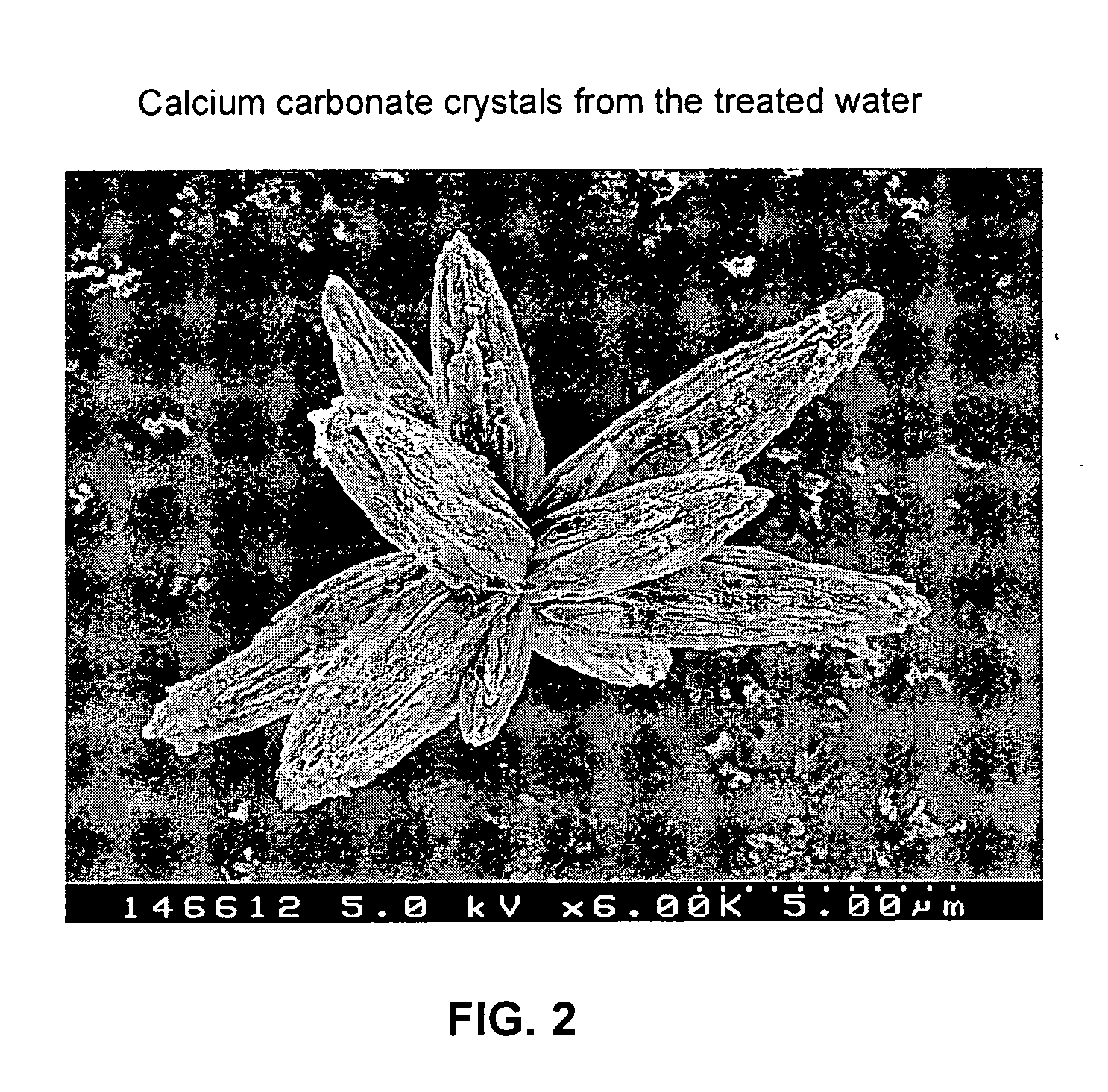Systems and methods for generation of low zeta potential mineral crystals to enhance quality of liquid solutions
a technology of liquid solution and mineral crystals, which is applied in the direction of specific water treatment objectives, water/sludge/sewage treatment, food waste water treatment, etc., can solve the problems of serious health and safety concerns, contamination by harmful microorganisms, and the potability of certain water supplies, so as to enhance the overall quality of source liquids
- Summary
- Abstract
- Description
- Claims
- Application Information
AI Technical Summary
Benefits of technology
Problems solved by technology
Method used
Image
Examples
example 1
Chemical Analysis of Untreated and “Turbu-Flow™” Treated Water
[0076] A chemical analysis comparing the wet chemistry and elemental metal composition of untreated water and water treated with a Turbu-Flow™ low zeta potential generator is shown below in Table 1. The instrument detection limits are also provided. According to the results shown in Table 1, very little change can be detected in Turbu-Flow™ treated water, except that an increase in turbidity (a measure of the cloudiness of water caused by suspended particles) is observed.
TABLE 1InstrumentDetectionUntreatedTreatedLimitWaterWaterWetConductivity (us / cm)3720720Chem.pH (pH units)0.17.87.7Turbidity (NTU)0.100.300.50MetalsAluminum (mg / L)0.010.020.02Barium (mg / L)0.010.080.08Beryllium (mg / L)0.001Boron (mg / L)0.05Cadmium (mg / L)0.0001Calcium (mg / L)0.58485Chromium (mg / L)0.0010.0010.001Cobalt (mg / L)0.0008Copper (mg / L)0.0010.0590.052Iron (mg / L)0.050.110.11Lead (mg / L)0.001Magnesium (mg / L)0.52020Manganese (mg / L)0.0010.0040.004Molybdenu...
example 2
Kill Time Study
[0077] The following table illustrates the kinetics of the destruction of microorganisms using the Turbu-Flow™ system. This example shows that regular tap water treated by the Turbu-Flow™ system results in an equivalent level of decontamination as sterile, deionized water.
Inoculum Preparation:
[0078] Cultures of S. aureus ATCC #6538 and L. monocytogenes ATCC #19111 were transferred from stock cultures to individual tubes of Soybean casein digest broth (SCDB) media. Cultures were incubated at 30-35° C. for 24-48 hours.
[0079]A. niger ATCC #16404 was inoculated onto Sabouraud dextrose agar (SDEX) and incubated at 20-25° C. for 6-10 days. A. niger was harvested by removing the mycelial mats from the surface using a sterile spatula. The mycelia were placed into a sterile funnel containing moist cotton and rinsed with SALT, a solution of 0.9% saline with 0.05% Tween. Organism concentration was adjusted in Physiological Saline Solution (PHSS) to produce a challenge level...
example 3
Water Surface Tension Analysis
[0086] Samples of untreated water and water treated by passage through a Turbu-Flow™ system were generated and analyzed for surface tension at room temperature and at 80° C. The results of the analysis are summarized in Table 3.
TABLE 3Untreated WaterTurbu-Flow Treated WaterDateRoom Temp80° C.Room Temp80° C.May 5, 200479.0na69.5nadynes / cmdynes / cmMay 25, 200479.169.277.467.5dynes / cmdynes / cmdynes / cmdynes / cm
[0087] Table 3 shows a dramatic decrease in water surface tension after a single pass through the Turbu-Flow™ system. The sample was analyzed approximately one week later. Based on a one-week-old sample, the surface tension dropped from 79.0 dynes / cm in the untreated water to 69.3 dynes / cm in the water treated by the Turbu-Flow™ system.
[0088] To further delineate the impact of time and temperature on the surface tension, the analysis was repeated almost three weeks later. At this time, the treated water sample exhibited only a slight decrease in surf...
PUM
| Property | Measurement | Unit |
|---|---|---|
| Fraction | aaaaa | aaaaa |
| Fraction | aaaaa | aaaaa |
| Zeta potential | aaaaa | aaaaa |
Abstract
Description
Claims
Application Information
 Login to View More
Login to View More - R&D
- Intellectual Property
- Life Sciences
- Materials
- Tech Scout
- Unparalleled Data Quality
- Higher Quality Content
- 60% Fewer Hallucinations
Browse by: Latest US Patents, China's latest patents, Technical Efficacy Thesaurus, Application Domain, Technology Topic, Popular Technical Reports.
© 2025 PatSnap. All rights reserved.Legal|Privacy policy|Modern Slavery Act Transparency Statement|Sitemap|About US| Contact US: help@patsnap.com



